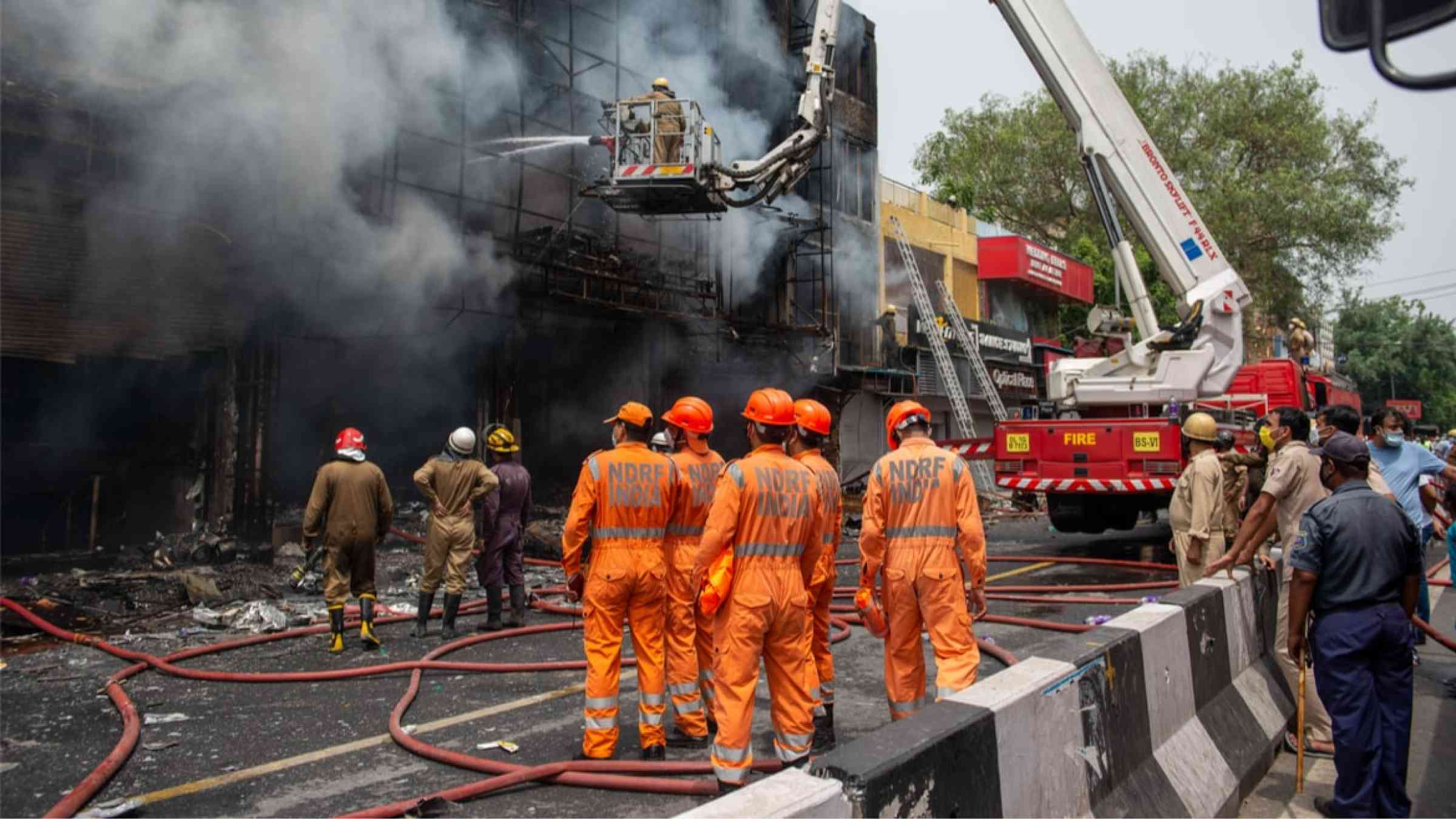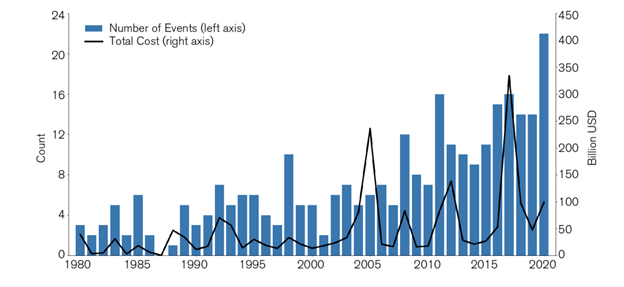What is climate intelligence – and how can it help address climate change?

- Climate intelligence can help businesses monitor their exposure to climate risk more accurately.
- Large-scale climate datasets aggregated from sensors, satellites and science enable climate intelligence.
- Climate risk disclosure mandates are critical in accelerating climate intelligence adoption.
Post COP26, much of the current narrative around climate change has centered on mitigation and the lack of robust emission reduction targets to keep planetary warming under 1.5°C. While short-term reductions are critical to stabilizing our future climate, countries must still address the immediate, intensifying physical risk from increasing climate volatility that is already locked into the system. In 2016, a Nature Climate Change study calculated that up to $24.2 trillion (or 16.9%) of global financial assets could be at risk due to climate change.
Since the early 2000s, the UNFCCC has reported on climate-related risks, including heatwaves, droughts, floods, cyclones and wildfires. However, it was not until recently – with the recommendations of the Task force on Climate-related Financial Disclosures (TCFD) – that demand has grown to find technologies that model, forecast and provide insights on climate hazards to mitigate physical and transitional risks.
The rise of climate intelligence
In response, a new category of climate technology has emerged: climate intelligence (CI). Described as business intelligence for managing climate risk, CI is historical, current and predictive information on our natural and built systems used to power insights for climate mitigation and adaptation. “Climate intelligence puts climate at the core of decision-making. Enterprises, governments and NGOs use it to make climate-aligned decisions,” said Iggy Bassi, Founder & CEO of Cervest, a UK-based climate intelligence company.
Unprecedented advancements in science and technology, including machine learning (ML) and artificial intelligence (AI), are accelerating the collection, processing and analysis of climate data, permitting the development of climate intelligence. Large-scale datasets are being scaled down to the local and asset levels to enable firms to make more effective decisions, and historical data is being used to build predictive models for near- and long-term climate risks. For example, take a global real estate company that has multiple assets (buildings) throughout the world. This company can use climate intelligence technology to understand their climate physical risks, such as rising sea level, wildfire and extreme wind, at each of their individual assets and decide how and when to mitigate and/or adapt to them.
Steven Rothstein, Managing Director of Ceres Accelerator for Sustainable Capital Markets
Over the past few years, early-stage climate technology has experienced a boom in venture capital investment, reaching $17 billion in 2020, with a number of these investments comprising climate intelligence and risk-modelling technologies. However, the widespread adoption of climate intelligence depends on certain conditions. One is a change in the regulatory landscape of climate-risk disclosure, an imperative first step for companies to acknowledge, measure and assess the impacts of climate change on their businesses. Regulation in the sector has traditionally lagged behind science. In 2010, the Securities and Exchange Commission (SEC) published an interpretive guidance for publicly traded US companies to consider the effects of climate change, but it did not mandate disclosure of climate risks on their businesses. As of 2019, only 30% of the largest 3,000 publicly traded US companies discussed climate change as a risk in their annual report.
“The first step to managing climate risk is measuring climate risk,'' says Steven Rothstein, Managing Director of Ceres Accelerator for Sustainable Capital Markets. “The work of the SEC and other regulatory agencies in the United States and key agencies around the world is vital. Investors and the capital markets need clear comparable information on climate risk and mandatory corporate disclosure is a critical tool in this effort.”

Billion-dollar climate disaster events in the United States
Image: Financial Stability Oversight Report (FSOC) Report on Climate-Related Financial Risk
In 2020, the US recorded 22 climate and weather disaster events in 2020 that caused over $100 billion in damages. In July 2021, SEC Chair Gary Gensler announced that they would consider adopting regulations regarding mandatory climate-risk disclosures for public companies. This announcement lagged behind the UK, who had already published a roadmap in November 2020 that outlines a plan for such an obligation aligned with the recommendations of the TCFD.
These regulatory announcements and decisions have led to more companies voluntarily disclosing climate data and information. In October 2021, environmental non-profit CDP reported that over 13,000 companies worth over 64% of global market capitalization had revealed data on climate change, water security and deforestation in 2021, an increase of 37% since 2020. Despite progress on disclosure, there are still issues that remain. Incomplete information can lead to markets underestimating climate risks, and the lack of a standardized method and framework for disclosures reduces governments’ ability to mandate them.
Additionally, whether voluntary or mandatory, climate risk disclosure is only the first step and does not ensure the quality of the information reported. Climate intelligence can facilitate better quality disclosures by enabling companies to analyze their exposure to climate risk more accurately and quickly than ever before, and is a necessary tool for companies to address their risks.
The power of climate intelligence
There are many ways climate intelligence can accomplish this. Cervest’s AI-powered product suite delivers dynamic, cloud-based climate intelligence that unifies climate data with earth science expertise, data modeling and machine learning to present a standardized and science-based view of risk across millions of global assets at the individual level. Futureproof quantifies climate physical risks for insurers, asset managers and banks by evaluating the probability of asset default and loss damage. Alternatively, ClimateAI is developing artificial intelligence to help farmers make informed decisions about how to optimally plant, grow and harvest crops according to changing temperatures and weather patterns.
What’s the World Economic Forum doing about climate change?
Climate change poses an urgent threat demanding decisive action. Communities around the world are already experiencing increased climate impacts, from droughts to floods to rising seas. The World Economic Forum's Global Risks Report continues to rank these environmental threats at the top of the list.
To limit global temperature rise to well below 2°C and as close as possible to 1.5°C above pre-industrial levels, it is essential that businesses, policy-makers, and civil society advance comprehensive near- and long-term climate actions in line with the goals of the Paris Agreement on climate change.
Global warming can be beaten thanks to this simple plan
The World Economic Forum's Climate Initiative supports the scaling and acceleration of global climate action through public and private-sector collaboration. The Initiative works across several workstreams to develop and implement inclusive and ambitious solutions.
This includes the Alliance of CEO Climate Leaders, a global network of business leaders from various industries developing cost-effective solutions to transitioning to a low-carbon, climate-resilient economy. CEOs use their position and influence with policy-makers and corporate partners to accelerate the transition and realize the economic benefits of delivering a safer climate.
Climate intelligence is necessary for companies to more accurately and easily understand their climate risks and opportunities. More governments and regulators must mandate climate risk disclosure, and recommend robust and standardized frameworks to guide the necessary solution developments. Also, the public and private sector will need to continue to invest in and work with early-stage climate intelligence providers to develop risk-response use cases and commercial applications in order for this technology to be user-friendly and widely adopted.